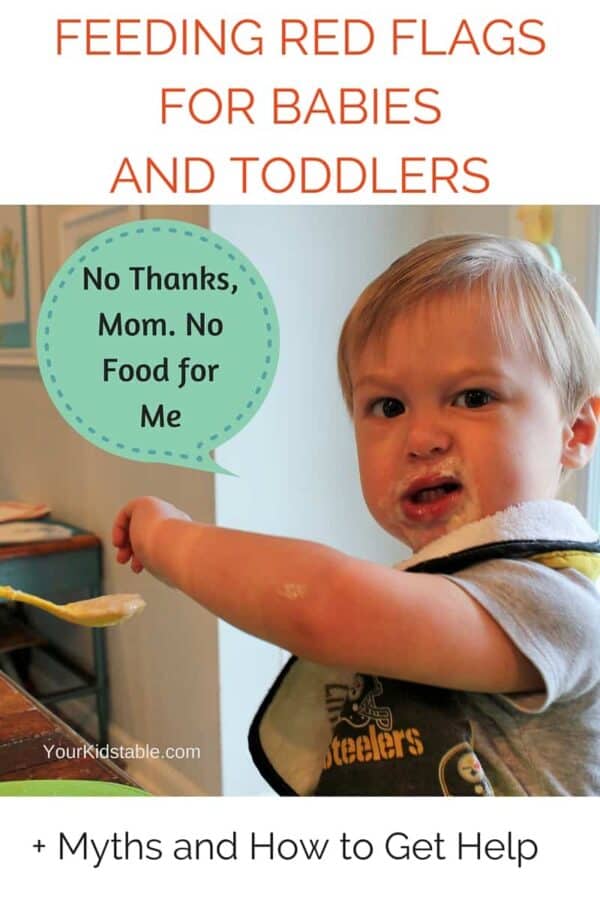Toddler Drank Vitamin D Drops

One of the most popular reasons parents find their way to Your Kid's Table is because their baby or toddler isn't eating baby food, table food, or both. Obviously, this is a huge area of concern for parents. These refusals are usually a red flag that something deeper is going on with their eating, and if it isn't addressed, it could lead to long years of picky eating and feeding difficulties that causes the whole family stress.
I've helped so many families of 2, 4, 6, 8, or even 12 year olds that are in a really desperate spot, and one of the first questions I ask (even for a 12 year old) is, "How did they transition to table foods?" It gives me a clue as to how the whole feeding thing got so out of control, because it's usually a big piece of the puzzle. I really want to help parents avoid that! So, let's talk about what those feeding red flags are for babies and young toddlers!
Feeding Red Flags
1. Refuses Baby Food – Not all babies love the mushy pureed stuff, and many don't gobble it down jar after jar the way other babies do. But when a baby consistently refuses and even becomes upset when presented with baby food, it is usually a red flag that there may be some sensory sensitivity.
2. Refuses Table Food – Often when babies refuse pureed foods, logically, parents will start trying table foods. In fact, that is just what I would recommend. However, if a baby is refusing pureed foods because of the mushy texture, they also may not be too keen on bananas or avocados. I always recommend starting with a dry and crunchy melt-able like baby puffs. If a baby is steadily refusing those and all other foods, then that is a clear indication that something else is going on. (See the free printable for more help below).
3. Gags at sight, touch, taste of baby food or table food repeatedly – Some gagging when touching or trying new foods is normal, but if your baby or toddler does this every time, then it's a strong indicator that they are sensitive to different textures. Get an entire guide to toddler and baby gagging. You'll find tips for how to past it.
4. Gags, spits food out, or seems to choke repeatedly when trying to chew or swallow food – I want to differentiate here a bit, because gagging or spitting out after the baby has started eating tends to indicate that a baby may be having difficulty coordinating the actions of chewing and/or swallowing. Learn how to help your child with oral motor exercises (free printable included).
5. Only interested in nursing or bottle feeding at 8 months old or later – By 8 months old, at the very latest, babies should be showing some interest in some type of food (puree, soft table foods, or crunchy foods).
6. Not feeding themselves – Sometimes children aren't able to coordinate the action, and of course, I don't expect a 6 month old to be able to feed themselves much, but kids that seem to be able, but unwilling, often don't want to. Feeding is something they've learned to accept, but it isn't something they desire to do, so they have no initiative to put food into their own mouth.
7. Only eats with distractions – If a young baby or toddler is only able to eat by being distracted by a tablet, TV, or a parent standing on their head, then they again are lacking the intrinsic motivation to eat, which can happen for a variety of reasons (see more here). It is a big bright red flag that something more is going on. Older toddlers and children can fall into this pattern for other reasons, but babies that have never been fed successfully another way, often need help to address the root of the problem.
8. Doesn't mouth on toys or chew on found items – I often hear from parents, "I thought it was so great that my son never put anything in his mouth." On the surface, that does seem awesome, but there is a reason babies do that. It desensitizes their mouth to different textures, helps build their jaw, tongue, and lip muscles needed for eating, and they get to practice chewing. If your child never did this and has one of the other red flags, it is likely that there are some underlying difficulties.

Myths
1. No teeth – If I had a dollar for every time I heard a parent say their child isn't eating because they don't have any teeth yet…. Well, you know how the rest goes! I hear this a lot, and I know that seems like good logic, but I want to shout from the roof tops: Babies and toddlers don't need teeth to eat successfully.
Really, I'm not kidding! Think about the first teeth babies get, which is anywhere from 6-14 months old. They are the front teeth. We don't use our front teeth to chew, and babies shouldn't be either. Their gums are strong and they should be chewing on them, right where their molars will be. It could be a year later before those molars come in.
Babies and young toddlers were designed to eat successfully at meals without teeth. Of course, there are some foods they shouldn't eat (nuts, lettuce, tough meat like steak, etc.), because they need teeth and more advanced chewing skills to manage. Other than those tough foods and a few choking hazards (popcorn, grapes, etc.), babies are able to eat a wide variety of foods without teeth.
2. They will grow out of it – I hear this A LOT too! But, it's not from the parents of babies that are under 15 months old. It is from the parents of 2, 5, 8 year olds plus. While some parents do arrive at this conclusion on their own because they honestly didn't know what else to do, sadly, most of the time, parents had a gut feeling something more was going on, but their pediatrician told them, "Don't worry, she is healthy, she'll grow out of it."
I'm not trying to knock pediatrician's here, they are amazing and I have had the privilege of working with some amazing ones, both personally and professionally. Unfortunately, many receive very little advanced training in feeding difficulties that aren't causing medical problems or weight loss.
Do I need more help?
Generally speaking, if your child has two or more of the red flags listed above, I would highly recommend getting a feeding evaluation, which is usually completed by OT's (like myself) and speech and language pathologists. However, in a lot of cases, only one of these red flags is enough to warrant an evaluation.
If your baby is not eating any foods by 9 months of age or no table foods by 11 months of age, I would also strongly encourage a feeding evaluation. More importantly though, if you feel like you don't know how to help your child and something in your gut is telling you that there's more going on, then get some help. You will be glad you did.
*Please keep in mind that babies born prematurely or present with developmental disabilities may be on a different timeline. Also, every child is unique and this information is tended to be a guide for parents to make decisions about potential interventions to help their child. If you still aren't sure if your child needs more help, leave a comment or hit the contact button in the menu bar.
How to Get help + A Free Printable
Two of the most direct ways to get help for your baby or toddler are:
- Early intervention – A free, usually in-home evaluation for children 0-3 in some states, and 0-5 in other states.
- Private therapy – Check with your individual insurance company first to schedule at a private clinic, outpatient facility, or children's hospital.
But, if you're still not sure, I have a free printable that will help give you some direction and ease your worries. It's for you parents (and there's more than you think) that are struggling to get your toddler or baby to eat table foods. I'll send it right to your inbox:
Grab the Free When Babies Won't Eat Table Foods FAQ Sheet right here!
More on Helping Babies and Toddlers Eat
How to Transition to Table Foods
Teach Your Child to Self-Feed
Feeding Milestones
Alisha Grogan is a licensed occupational therapist and founder of Your Kid's Table. She has over 15 years experience with expertise in sensory processing and feeding development in babies, toddlers, and children. Alisha also has 3 boys of her own at home. Learn more about her here .
Source: https://yourkidstable.com/baby-and-toddler-feeding-red-flags/







Tidak ada komentar:
Posting Komentar